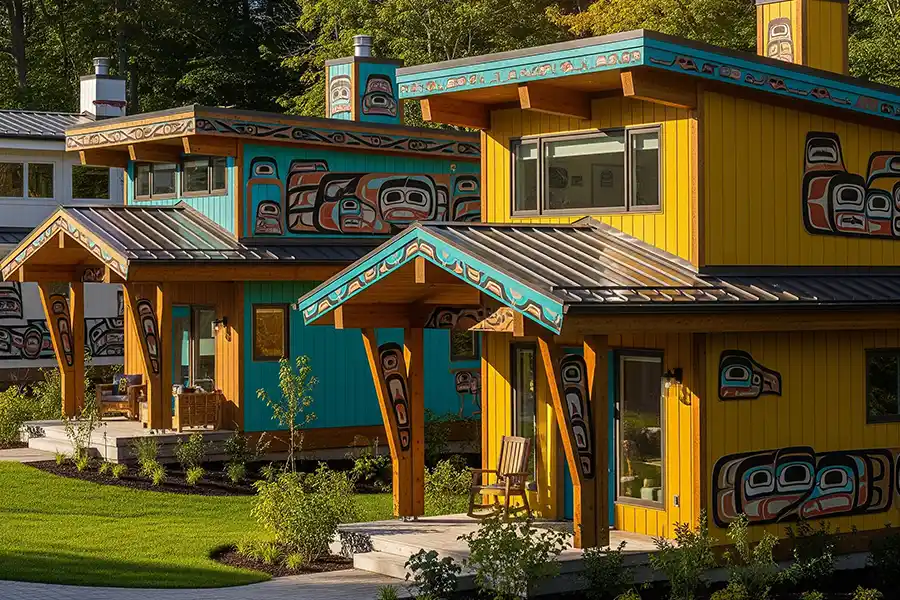Historical Foundations and Colonial Violence
Land acknowledgments are rooted in Indigenous traditions that recognize and express gratitude for the land and territory of First Nations, Inuit, and Métis peoples. These practices existed long before European contact and represent fundamental protocols for honoring the relationship between Indigenous peoples and their traditional territories.
Colonization inflicted systematic violence and cultural destruction upon Indigenous communities across North America. European settlers and governments implemented policies designed to eliminate Indigenous peoples through various means. In 1907, a government medical report found that 25 percent of all children who had attended residential schools in western Canada had died, with one school reporting a 69 percent death rate. Canada’s Truth and Reconciliation Commission estimated that more than 6,000 children died while at residential schools, giving students odds of dying comparable to Canadian soldiers serving in World War II.
The residential school system, operating from the 1870s until 1996 when the last school closed, was explicitly designed to “kill the Indian in the child.” Children were forcibly removed from their families, forbidden to speak their languages, practice their cultures, or maintain connections to their communities. Physical, sexual, and psychological abuse was endemic within these institutions.
The Sixties Scoop
The Sixties Scoop, beginning in the mid-1950s and continuing into the 1980s, represented another systematic assault on Indigenous families. Child welfare systems removed Indigenous children from their families and communities, placing them with non-Indigenous adoptive families. This practice severed cultural connections and contributed to ongoing intergenerational trauma.
Beyond institutional violence, settlers employed biological warfare tactics. Historical records document at least one verified instance in 1763 when British officials deliberately distributed smallpox-infected blankets to Indigenous peoples, with one eyewitness noting: “we gave them two Blankets and an Handkerchief out of the Small Pox Hospital. I hope it will have the desired effect”. While the extent of such practices remains debated among historians, disease epidemics—whether deliberately spread or resulting from contact—devastated Indigenous populations across the continent.
These historical traumas created intergenerational effects that persist today, manifesting in ongoing discrimination, health disparities, and systemic inequities that Indigenous peoples continue to face.
Understanding Land Acknowledgments as Reconciliation Practice
Land acknowledgments represent more than ceremonial statements; they are Indigenous protocols used to express gratitude and honor the Indigenous peoples who have lived and worked on the land historically and presently. When implemented meaningfully, these acknowledgments serve as foundational steps toward reconciliation between Indigenous and non-Indigenous peoples.
Acknowledging traditional territories involves recognizing historical injustices, understanding the ongoing effects of colonization, and working toward healing relationships. This practice promotes education about the land’s original stewards and their continuing presence and rights.
Non-Indigenous Canadians live and work on Indigenous territories throughout the country. Learning about these places and their histories is essential for understanding our contemporary responsibilities. This education process may involve confronting uncomfortable truths about colonization and examining personal and societal biases that have shaped relationships between Indigenous and non-Indigenous peoples.
Implementation in Business and Institutional Settings
Organizations in Burlington and across Canada have opportunities to meaningfully integrate land acknowledgments into their practices. This implementation extends beyond website statements to include company profiles, social media channels, and physical locations where appropriate.
Businesses that incorporate land acknowledgments demonstrate their commitment to reconciliation and Indigenous rights. However, these acknowledgments must be accompanied by genuine education and action rather than serving as performative gestures. Organizations should consider how their practices and policies align with their stated recognition of Indigenous sovereignty and territorial rights.
Activating Indigenous Governance and Cultural Protocols
Territorial acknowledgments function as activations of Indigenous culture and governance systems rather than mere historical references. By recognizing traditional territories, these acknowledgments affirm the ongoing presence and resilience of Indigenous communities while acknowledging their continuing sovereignty and cultural rights.
This recognition represents a step toward understanding and respecting Indigenous governance structures that predate and continue alongside colonial institutions. Land acknowledgments should prompt reflection on the relationship between Indigenous sovereignty and contemporary territorial occupation by non-Indigenous peoples.
Educational Dimensions and Personal Responsibility
Land acknowledgments serve an educational function, prompting individuals to examine their relationship to the land and to Indigenous peoples. This reflection should extend beyond acknowledgment to include personal introspection about biases, assumptions, and the individual’s role in perpetuating or challenging colonial structures.
Educational engagement with land acknowledgments involves learning about specific Indigenous nations, their histories, their contemporary realities, and their ongoing struggles for recognition and justice. This education forms the foundation for building authentic relationships with Indigenous communities.
Moving Beyond Acknowledgment Toward Reconciliation
Land acknowledgments serve as reminders of historical dispossession and ongoing injustices while pointing toward the necessity for informed action and authentic relationship-building. These acknowledgments should catalyze movement beyond recognition toward concrete efforts to address systemic inequities and support Indigenous sovereignty.
Meaningful reconciliation requires sustained commitment to understanding Indigenous perspectives, supporting Indigenous-led initiatives, and examining how individual and institutional practices can align with principles of justice and equity. Land acknowledgments provide an entry point for this deeper engagement, but they represent the beginning rather than the conclusion of reconciliation work.
The ultimate goal extends beyond Canadian borders to fostering more equitable relationships with Indigenous peoples globally. However, for non-Indigenous people living on Indigenous territories in Canada, the immediate responsibility involves engaging with the specific Indigenous nations on whose traditional lands they reside, learning their histories, and supporting their contemporary struggles for recognition, justice, and self-determination.

